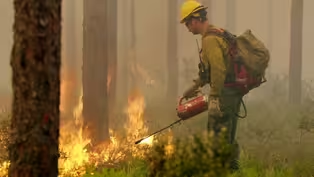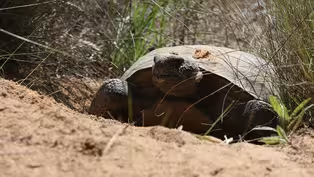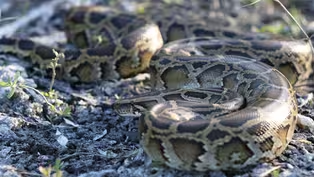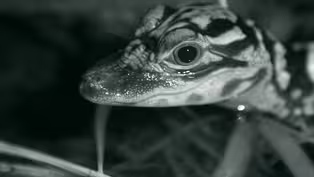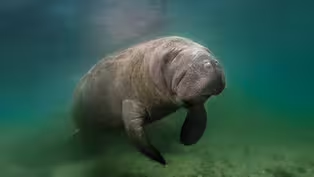
Wild Florida
Season 38 Episode 11 | 53m 13sVideo has Closed Captions
Discover the wildlife of Florida and how experts are battling threats to its ecosystems.
Florida is home to beaches, coral reefs, pine forests and the famous Everglades wetland, but a growing human population and abandoned exotic pets like pythons are threatening this wild paradise. Can Florida’s ecosystems continue to weather the storm?
Problems playing video? | Closed Captioning Feedback
Problems playing video? | Closed Captioning Feedback
Major support for NATURE is provided by The Arnhold Family in memory of Henry and Clarisse Arnhold, Sue and Edgar Wachenheim III, The Fairweather Foundation, Charles Rosenblum, Kathy Chiao and...

Wild Florida
Season 38 Episode 11 | 53m 13sVideo has Closed Captions
Florida is home to beaches, coral reefs, pine forests and the famous Everglades wetland, but a growing human population and abandoned exotic pets like pythons are threatening this wild paradise. Can Florida’s ecosystems continue to weather the storm?
Problems playing video? | Closed Captioning Feedback
How to Watch Nature
Nature is available to stream on pbs.org and the free PBS App, available on iPhone, Apple TV, Android TV, Android smartphones, Amazon Fire TV, Amazon Fire Tablet, Roku, Samsung Smart TV, and Vizio.
Buy Now
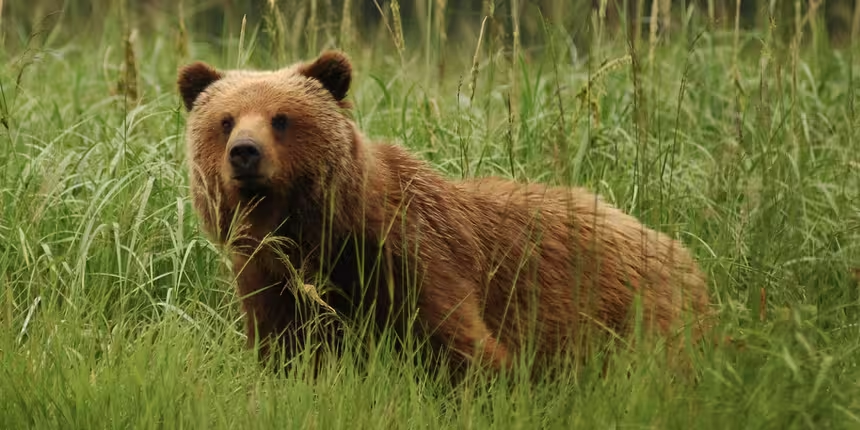
Explore More Ways to Watch
Bring the beauty and wonders of wildlife and natural history into your home with classic NATURE episodes.Providing Support for PBS.org
Learn Moreabout PBS online sponsorship♪♪ [ Waves crashing ] NARRATOR: Florida -- the Sunshine State.
A paradise of beaches and backwaters.
And a haven for original Floridians far older than the 27th state.
♪♪ These wild residents know more than sunny winters.
♪♪ They know the extremes of fire and flood... the fury of storms, the forces of change.
But a rising human population and a cast of animal invaders are now adding to the challenges they face.
While some are fighting hard to save them, the native wildlife is finding its own ways to adapt.
But can this sunny corner of the USA continue to weather the growing storm?
♪♪ ♪♪ ♪♪ NARRATOR: Florida is a corner of America that's a state apart.
It dips deep to the south, almost to the tropics, and it's the only state affected by both subtropical and tropical climates.
♪♪ So while it's rightly famous for sunshine... torrential rains pour down during the humid summer months.
♪♪ It's a dynamic mix that, for millennia, has supported many creatures found nowhere else in the US... [ Flamingos squawking ] ...and shaped unique habitats.
♪♪ From pine forests in the north to the coral reefs at the Florida Keys... ♪♪ ...this is one of the most biodiverse places in the world.
But perhaps its most iconic landscape lies in the south.
The Everglades.
A 1 1/2 million-acre wetland on Florida's southern tip.
♪♪ This is the largest subtropical wilderness in the United States.
[ Birds chirping ] ♪♪ It can hold around a trillion gallons of water, and it's brimming with life.
♪♪ Hundreds of marshland species live here all year round alongside thousands of visiting birds in winter and spring.
[ Bird croaking ] ♪♪ It's called a "wetland," but, in fact, this is a giant, slow-moving sheet of water, earning it the name the "River of Grass."
♪♪ Winter into early spring is Florida's dry season.
[ Insects chirping ] With almost no rain and a baking sun, water levels here reach their lowest, and there's a strange sound in the air.
[ Bellowing ] ♪♪ ♪♪ Male alligators are bellowing.
[ Bellowing continues ] ♪♪ ♪♪ To find each other in this vast expanse of water, they vibrate their larynx to let out deep growls.
[ Bellowing continues ] Low-frequency sounds, inaudible to human hearing, make the water dance.
[ Water splashing ] ♪♪ It tells other alligators how big and strong they are, and it can be heard over a mile away.
♪♪ The sound wards off competitors... ♪♪ ...and, hopefully, attracts a mate.
[ Insects chirping ] Females can be quick to respond.
[ Alligator growling ] But they're not always quick to pick a partner.
[ Alligators growling, bellowing ] They lead males into a slow dance before finally deciding he's the one.
[ Alligator growling ] The wooing can last for days... ...with couples mating multiple times.
[ Insects chirping ] But soon, they go their separate ways.
The males might partner again.
But females now turn their attention to building a nest.
In just a month's time, it needs to be ready for their eggs.
Alligators are so successful here.
They've dominated this landscape for millennia.
But now their freshwater world is under serious attack.
[ Alligator bellowing ] ♪♪ In the last century, 65% of this wetland has been drained for human use.
More than eight million people rely on the Everglades for their drinking water.
♪♪ But the latest problem for the native species is unwanted exotic pets.
Florida's sunny climate helps non-native residents thrive here, too.
♪♪ Perhaps the most destructive is the Burmese python.
Originally from the jungles and marshes of Southeast Asia, a staggering 100,000 of these invasive reptiles are now estimated to be thriving in the Everglades.
With few natural predators, these invaders are almost unstoppable.
♪♪ But people are fighting back.
♪♪ KALIL: Burmese pythons came here in the '70s from the pet trade.
People didn't know what to do with them, so they came out here and let them go.
♪♪ NARRATOR: Licensed python hunting is now permitted in the Everglades year round.
KALIL: They've been eating their way through the Everglades National Park.
Literally 98% of the mammals have been eaten by these Burmese pythons.
They're eating deer, they're eating alligators.
We brought them here, we need to take them out.
And that's what I'm here to do.
NARRATOR: Paid contractors patrol the levees around the Everglades day and night.
[ Grass rustling ] ♪♪ Female pythons can lay over 100 eggs a year and grow to be more than 18 feet long.
♪♪ FEMALE SNAKE HUNTER: Stop!
Stop for a second.
♪♪ KALIL: Grabbing a big constrictor like that is an experience.
You definitely have to go in, grab it with both hands, make sure you know what you're doing.
You don't want it to wrap around your neck because it can kill you.
♪♪ NARRATOR: In the first two years of the removal program, 25 teams took out almost 2,000 adult snakes.
♪♪ But there's much more to be done.
KALIL: The war that we're fighting is bigger than the battle that we're winning.
You're not doing your pet a favor by letting them go.
You think, you know, "Here, be free!
Have fun!"
It doesn't work that way.
NARRATOR: Once captured, the pythons have to be humanely destroyed.
♪♪ But as fast as Floridians tackle one invader, another appears.
Nile monitors, Africa's largest lizard, are eating Florida's endangered burrowing owls... ...while another large lizard, the tegu from Argentina, has a taste for the eggs of indigenous turtles.
There are now more than 500 non-native species living here.
♪♪ It might seem overwhelming, but as pressures grow, people like Donna are vital to the future of Florida's native landscapes.
♪♪ In the dry sandhills to the north lies the Apalachicola region of Florida's panhandle.
Here, residents face a very different challenge -- to keep one of Florida's most ancient habitats alive.
It's April, the height of the dry season in the longleaf pine forests.
These native trees once covered much of the state.
But after years of logging, this is now their last stronghold.
They grow in open, light-filled forests on dry, sandy soils -- a world away from the watery expanse of the Everglades.
[ Birds chirping ] On the forest floor, one of its most unassuming residents is out looking for food.
A gopher tortoise.
The open savanna beneath the trees makes it easy to move around and feed.
But at this time of year, the wiregrass is tinderbox dry... ♪♪ ...and the weather can change in an instant.
[ Wind howling ] [ Thunder crashes ] Florida is the lightning capital of the United States.
[ Crashing continues ] Over a million bolts strike each year... and just one can ignite the parched landscape.
♪♪ But this isn't the disaster it looks like.
This forest needs fire to survive.
The trees can take the heat as the flames clear the forest of unwanted scrub.
♪♪ This allows new longleaf pine to germinate and grow without competition.
Everything living here has to find a way to cope with the inferno.
Including the gopher tortoise.
♪♪ He seeks out sandy soil on higher ground and uses his shovel-like feet to dig burrows.
These are a refuge from the flames.
And it's not just the tortoise that relies on them.
Over 300 species use these tunnels to shelter from fire, hurricanes, and all the extremes Florida's climate can throw at them.
That's why the gopher tortoise is one the most important animals in these forests.
♪♪ But a landscape that needs fire creates major conflict in a state with a growing human presence.
Almost 900 people move here every day, adding to a population of 20 million.
To protect homes, lightning-strike fires must be put out immediately.
[ Helicopter blades whirring ] ♪♪ PRINTISS: We can't have fires just moseying around the landscape.
There is people that would be in harm's way, there are houses, and people's livelihoods would be affected.
♪♪ NARRATOR: To keep longleaf forests alive, here burns are man-made and carefully managed by organizations like The Nature Conservancy.
PRINTISS: Fire needs to be addressed, really, anywhere, through prescribed fire.
We have to manage the fire, we have to keep it safe.
However, we do our best to mimic what Mother Nature would've done with naturally ignited fires.
The idea of fire is an ecological disturbance, but that really puts a negative spin on it.
This chaotic, seemingly destructive force is Mother Nature's great rejuvenator.
NARRATOR: Fire has been a feature of this landscape for millennia, and by keeping the natural cycle alive, Floridians are leading the way in controlled fire management across the United States.
[ Helicopter blades whirring ] They've reduced the risk of wildfires and restored thousands of acres of longleaf pine... ♪♪ ...a unique habitat that more than 900 species call home.
♪♪ [ Animals chittering ] ♪♪ In a state where landscapes naturally need to burn, waterways provide essential fire breaks.
Flowing through this longleaf stronghold is the mighty Apalachicola River.
♪♪ It's one of 20 major rivers in the state that create the enchanting swamps and wetlands Florida is famous for.
♪♪ Trillions of gallons of rain fall each year... ♪♪ ...and even in the dry season, few rivers ever run completely dry.
♪♪ And that includes Florida's network of more than 700 warm springs.
♪♪ This is Silver River in central Florida.
It's one of the largest freshwater springs in the United States.
20 million gallons of water flow out of the ground every hour.
Enriched with minerals from the earth, the spring water is crystal clear.
It's a balmy 72 degrees Fahrenheit all year round, which attracts one of the state's most magical animals.
♪♪ A Florida manatee.
♪♪ They spend most of their lives around the coast... ♪♪ ...but can't survive in water cooler than 68 degrees.
♪♪ So in winter, they head inland to Florida's springs.
♪♪ It's so warm and shallow here that algae blooms on their backs.
♪♪ They were critically endangered, partly because routes to warm waters like these were blocked by increasing development.
♪♪ But thanks to efforts across the state, by 2016, their numbers exceeded 8,000.
They're becoming a common sight once again.
♪♪ [ Animals chittering ] But this winter refuge doesn't just attract manatees.
[ Bird croaking ] Resident and migratory birds come here to rear their young.
[ Birds chirping ] And as spring unfolds, the river banks become a nursery ground.
Parents must be on their guard... [ Bird cries ] ♪♪ ...as danger is never far away.
♪♪ ♪♪ This moorhen has seven young chicks... ♪♪ ...and they're all eager to explore.
♪♪ They don't realize the peril they're in.
♪♪ ♪♪ [ Chick chirping ] As one finds out too late.
♪♪ These baby alligators are last year's hatchlings, and at eight months old, they're already expert ambush predators.
♪♪ As new life here blossoms, adults and their young make the most of the calm weather.
All too soon, things are going to change.
♪♪ June marks the arrival of summer.
♪♪ And here in Florida, the sun's powerful energy bites back.
♪♪ Every day, as temperatures rise, humidity builds and clashes with cooler air high up in the atmosphere.
[ Thunder rumbling ] Every afternoon, like clockwork, the clouds dump their contents.
♪♪ The wet season has begun... [ Thunder rumbling ] ♪♪ ...dousing Florida in 60% of its annual rainfall in just four months.
♪♪ ♪♪ The rain restores sunbaked landscapes... ♪♪ ...fire scarred forests, and fills the Everglades to their brim.
♪♪ With an average of 60 inches of rainfall each year, the Everglades is now the wettest place in Florida, and this is the most important time of the year for alligators.
Tucked away amongst the saw grass, alligator nests have been incubating eggs for two months now.
They're built around the roots of small trees, which anchor them as water levels rise.
A female guards each one, patiently waiting for her young to emerge.
And by August, the first babies have hatched.
[ Young alligators chirping ] At just a week old, they're perfectly camouflaged.
[ Chirping continues ] Bright yellow stripes make them invisible among the dried grasses the nest is built around.
At this age, they spend their days close together in pods... ...under the gaze of their watchful mother.
♪♪ Only eight inches long, they're defenseless, an easy meal for a passing bird or hungry male alligator.
♪♪ But when darkness falls, these hatchlings show a different side.
♪♪ With fewer predators around, the youngsters take on a new confidence.
[ Young alligators chirping ] ♪♪ They break away from their pods and set out alone.
And while they might look cute, even at this tender age, they already have the instinct to hunt.
♪♪ ♪♪ Their mother will protect them, but she won't feed them... ♪♪ ...so they have to get the hang of it fast.
♪♪ They hunt all through the night... ♪♪ ...pouncing on their prey of tiny insects and fish with not-quite-expert precision just yet.
♪♪ ♪♪ [ Young alligator chirps ] They'll perfect these skills over the next year until they're big enough to go it alone.
♪♪ With the deluge of summer rains, there's now a lot more water on the move.
♪♪ And it runs into a problem.
Highway 41.
♪♪ Built in the 1920s, before people realized the Everglades was a moving sheet of water, this road intersects the vast wetland east to west and inadvertently stops the flow.
♪♪ It's thought that disruption to water levels like this is responsible for the disappearance of 90% of the area's wading birds.
♪♪ In an attempt to restore the flow, giant pumps shift billions of gallons of water... ♪♪ ...and raised bridges allow the water to course once more.
♪♪ This helps the animals -- and also the people who live around its edge.
The Everglades is a giant, natural storm defense, its grassy innards able to soak up vast amounts of water and energy.
♪♪ This reduces flooding and damage to property when hurricanes hit.
♪♪ And as the summer heat intensifies, it becomes a certainty these giant storms will start to form.
[ Wind howling ] ♪♪ ♪♪ So before they do, the last of the seasonal visitors must depart.
[ Birds chirping ] ♪♪ Swallow-tailed kites have been here since March.
♪♪ Two-thirds of the North American population comes to Florida each year to breed.
♪♪ Courting, feeding, drinking, and even bathing on the wing... ♪♪ ...the feet of these extraordinary birds almost never touch the ground.
♪♪ ♪♪ They're about to make the 5,000-mile journey to their winter feeding grounds in South America... [ Birds chirp ] ...and the birds gather en masse to prepare.
♪♪ As they store up energy for the flight, it's vital they aren't disturbed, so they roost in remote places, far from people.
[ Birds chirping ] After a morning bath, the kites preen their feathers to keep them in condition for the long journey to come.
♪♪ ♪♪ They appear to sense atmospheric changes as hurricanes begin to approach.
♪♪ But far from avoiding these storms, researchers suggest the birds capitalize on their headwinds.
♪♪ And when the time is right, they take flight.
♪♪ Hundreds, even thousands, soar above roosts at this time of year.
♪♪ Their journey south can take up to four months... and there's time for one last feed.
Now the birds head straight to a landscape created by us.
[ Cows lowing ] Agricultural pastures are alive with insects.
[ Dragonfly wings flutter ] ♪♪ And this is where their forked tails come in.
♪♪ They use them as a rudder.
♪♪ ♪♪ ♪♪ They discard the wings and fuel up on the protein-rich bodies of their prey.
♪♪ ♪♪ ♪♪ ♪♪ Once they've had their fill, it's finally time to leave.
♪♪ [ Cows lowing ] [ Thunder crashes ] Their roosts are left eerily empty.
Florida's indigenous tribes call them the "leaders of the hurricanes."
As they vanish, the storms roll in.
[ Wind howling ] Fueled by the summer sun, they've been forming thousands of miles away, far out in the Atlantic.
[ Thunder crashes ] Rising temperatures have warmed the ocean surface, and as warm air rises from the water, it lifts moisture with it, creating giant stacks of clouds.
[ Thunder crashing ] ♪♪ As more air is sucked in below, winds begin to spiral inward, and a vortex is formed.
[ Wind howling ] The storm travels, gathering strength from the warmth below.
When its winds reach 74 miles per hour, it becomes an unstoppable force.
[ Waves crashing ] ♪♪ A hurricane is unleashed.
The warmest waters create a path for these monster storms to follow.
This is Hurricane Alley, and it brings many of them barreling straight into Florida.
[ Wind howling ] ♪♪ This state has experienced more direct hits by hurricanes than anywhere else in North America.
And they're getting stronger.
[ Wind howling ] Research tells us human-induced climate change is a driving force.
Our oceans are the hottest they've been since records began.
And this energy makes hurricanes more powerful than ever before.
[ Wind howling ] When Hurricane Michael struck in 2018, it was one of the most powerful storms to ever make landfall in Florida.
[ Waves crashing in distance ] ♪♪ With winds of 155 miles per hour, Michael flattened entire towns and ravaged the landscape.
♪♪ ♪♪ ♪♪ The longleaf pine forests in Apalachicola faced the full force of the storm.
♪♪ Yet remarkably, not only do these trees cope with fire, they can withstand hurricanes too.
♪♪ Where non-native species have snapped and fallen, the longleaf pines' supple trunks have bent with the winds.
Young growth has also survived... ♪♪ ♪♪ ...and the animals here have weathered the storm, too.
The gopher tortoise's burrow on higher ground has once more provided shelter for many forest creatures.
This is where native Florida comes into its own.
Its plants and animals are evolved to cope with the harshest forces of nature.
And these specially adapted, native survivors can be found across the state.
♪♪ At the southernmost tip lies the Florida Keys, an archipelago of more than 1,700 islands stretching south towards the tropics.
♪♪ Almost in the Caribbean, the islands are linked together by bridges... a tropical paradise for marine life and people alike.
But just a year before Hurricane Michael... ...there was Irma, a giant Category 4 storm that stripped mangrove trees bare... ...and contaminated fresh water with salt across the lower Keys.
[ Birds chirping ] Residents feared one of the Keys' most precious animals had been lost.
Yet remarkably, it's holding on.
♪♪ These are Key deer, a tiny, beautiful sub-species of white-tailed deer, found only on these islands.
♪♪ At just 28 inches tall, they're a third smaller than their mainland cousins.
♪♪ Scientists are unsure how they survived Irma, but almost 1,000 live across a cluster of islands in the Keys.
♪♪ And even in the aftermath of increasingly powerful hurricanes, they're finding ways to adapt.
♪♪ With many of their feeding grounds destroyed, the Key deer are now making themselves at home in urban areas.
♪♪ ♪♪ ♪♪ Happy to have them around, some residents provide fresh drinking water.
♪♪ But this reliance on humans is far from ideal.
♪♪ It brings them closer to roads... ♪♪ ...and a threat more lethal than hurricanes -- cars.
♪♪ ♪♪ From the tropical Keys... to the streets of Miami, the growing presence of humans is the latest unstoppable force facing the state.
♪♪ And despite its rising extremes, Florida's appeal doesn't seem to be fading.
♪♪ Tourism brings in 100 million people to its shores each year and accounts for almost 20% of employment.
But it's not without costs to the natural environment.
♪♪ Beneath the waves, the Keys hide a unique attraction.
The Florida Reef Tract.
It's the third-largest barrier reef in the world and the only one in North America.
♪♪ But pressure on this delicate habitat is mounting.
♪♪ ♪♪ As a barrier reef, it's another vital natural defense, absorbing the impact of storm surges before they hit land.
♪♪ [ Waves crashing ] Historically, these storms sheared off pieces of coral that would reattach elsewhere, creating a healthier reef.
But now, as storms are getting stronger, the reef doesn't have enough time to recover between them.
And alongside pressure from human use and our rapidly warming oceans, the Florida Reef Tract needs urgent help.
♪♪ Scientists are stepping in.
LEVY: If Florida lost the Florida Reef Tract completely, it's likely that we would see a place like Florida Keys completely washed away.
NARRATOR: The Coral Restoration Foundation is leading the way in saving reefs around the world.
♪♪ LEVY: The main corals that we worked with are staghorn and elkhorn, and the reason why we started there is those are the dominant corals that were found in Florida.
They've actually lost about 97% of their populations, so we've really focused our efforts into growing thousands upon thousands of these corals in a nursery setting.
NARRATOR: They've developed a pioneering system.
By suspending coral fragments in the water column, they give them 360 degrees of food and sunlight.
♪♪ This speeds up growth and produces new coral to restore the reef.
LEVY: So, we'll actually harvest them when they're ready from the nursery, and then we'll attach them directly onto the reef substrate in a process that we call outplanting.
Once we have a clean area or clean limestone, we then use this two-part marine epoxy, and we attach that epoxy to the reef, and then we gently press the coral directly into that epoxy.
NARRATOR: The fragments fuse with exposed limestone, forming new reef.
♪♪ By growing a genetically diverse mix of corals, the team hopes that at least some will be able to withstand the different threats the reef may face, giving it the best chance of survival in the future.
♪♪ They've planted more than 70,000 fragments in the past decade.
LEVY: It's now widely understood that active intervention is a necessity.
We're past the tipping point where they could recover naturally.
So, the point of a restoration program is to produce the abundance of corals and the diversity of corals that these reefs need to be able to keep up with their changing environments.
♪♪ NARRATOR: In spite of the growing pressures, people like Jessica... Donna... and David are pioneering new ways to help Florida's native landscapes... ♪♪ ...putting them in a better place to stand fast on the front lines of change.
♪♪ Florida is a state evolved to survive extremes, and for now its animals and landscapes are holding on.
♪♪ But finding a future that works for both people and wildlife here could be the greatest challenge this sunny corner of paradise has ever faced.
♪♪ [ Birds chirping ] O0 C1 ♪♪ ♪♪ ♪♪ To learn more about what you've seen on this "Nature" program, visit pbs.org.
♪♪
How Florida Firefighters Fight Wildfires with Fire
Video has Closed Captions
Clip: S38 Ep11 | 2m 55s | Longleaf pine forests need fire to survive and rejuvenate, but the fire threatens humans. (2m 55s)
How the Gopher Tortoise Saves Hundreds of Animals from Fires
Video has Closed Captions
Clip: S38 Ep11 | 1m 31s | When wildfires amass in Florida's Longleaf Pine forest, animals must find a way to cope. (1m 31s)
People Fight Back Against the Invasive Burmese Python
Video has Closed Captions
Clip: S38 Ep11 | 2m 53s | Burmese pythons have taken out about 98% of Florida's mammals but Florida's fighting back. (2m 53s)
Watch Baby Alligators Hunt at Night
Video has Closed Captions
Clip: S38 Ep11 | 2m 48s | Mother alligator watches over her young as they learn to hunt and fend for themselves. (2m 48s)
Video has Closed Captions
Preview: S38 Ep11 | 35s | Discover the wildlife of Florida and how experts are battling threats to its ecosystems. (35s)
Providing Support for PBS.org
Learn Moreabout PBS online sponsorship
- Science and Nature

Explore scientific discoveries on television's most acclaimed science documentary series.













Support for PBS provided by:
Major support for NATURE is provided by The Arnhold Family in memory of Henry and Clarisse Arnhold, Sue and Edgar Wachenheim III, The Fairweather Foundation, Charles Rosenblum, Kathy Chiao and...
